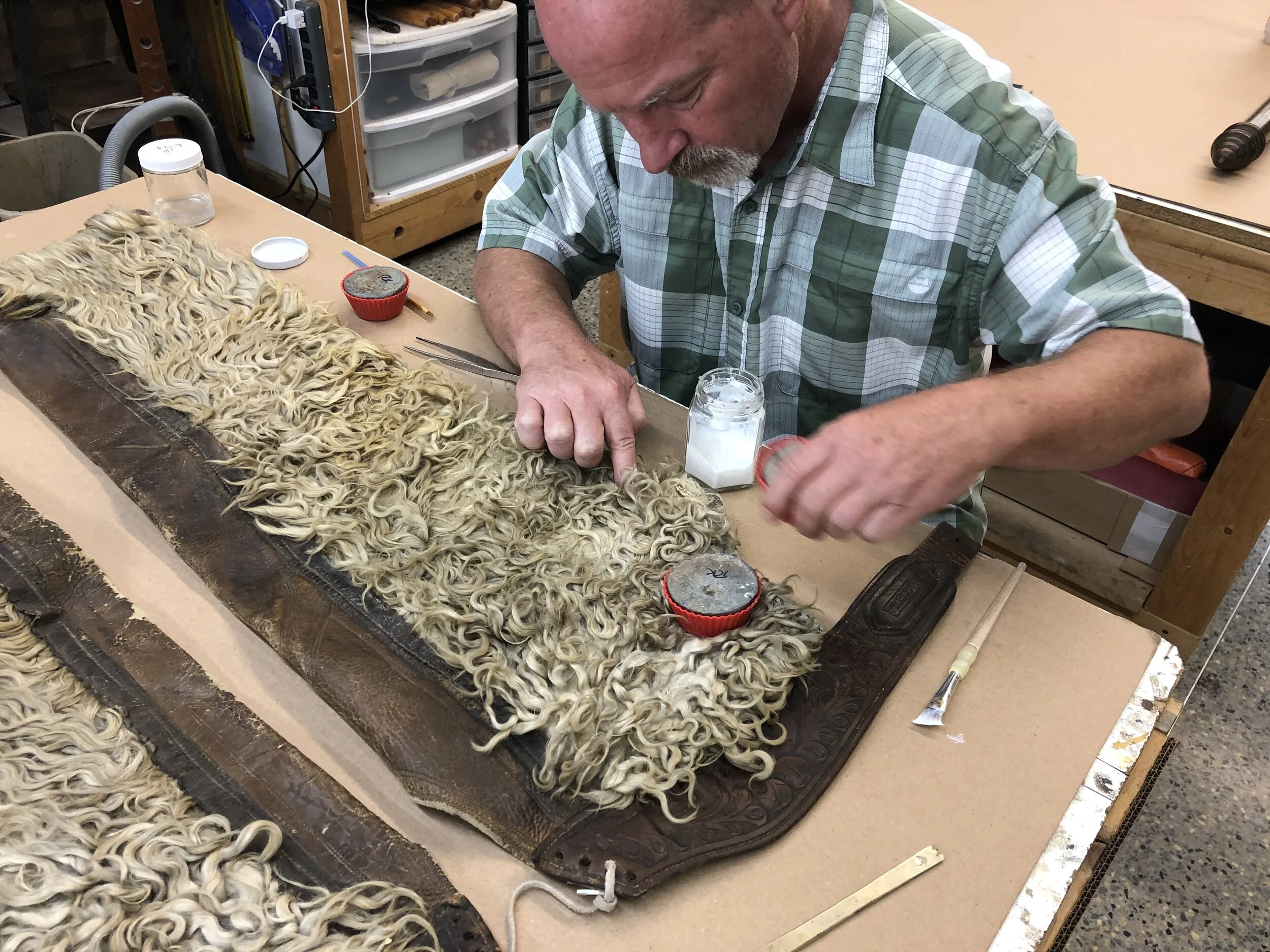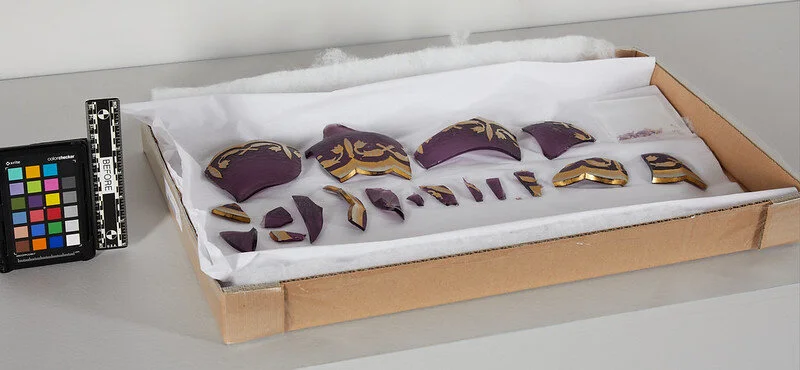Howdy, Partner! Conserving Chaps
Reparo! Conserving a Shattered Lamp
Through The Eyes of Lincoln: A Very Special Pair of Opera Glasses
Located in the Land of Lincoln, The Conservation Center sees its fair share of memorabilia connected to the 16th President of the United States. Among various Lincoln memorabilia, in 2014 we had the honor of restoring the courting couch, the sofa on which a young Abraham Lincoln and Mary Todd actually sat throughout their courtship in the home of Mary’s sister, Elizabeth. So when a Lincoln relic causes our conservators to stop in awe, rest assured it is a truly special item.
Treating a Tony Tasset Sculpture
Tony Tasset, though born and raised in Cincinnati, has developed deep roots in Chicago and is a recognized artist in the Chicago art world. After Tasset moved to Chicago to earn his MFA at the School of the Art Institute of Chicago in 1986, he has been actively producing art for the city to enjoy. Chicago residents and tourists alike might remember some of his public sculptures, such as the giant, 30’ tall eyeball sculpture in the Loop, the colorful storage-container sculpture from Grant Park that was transferred to the University of Illinois at Chicago campus where the artist now teaches, or the giant sculpture of a deer on the city’s newly-renovated Riverwalk showcased just last year.
"Mess is Less": Roger Brown's Unique Multimedia Piece
Though Roger Brown was born in Alabama and split his time between homes in Chicago, Michigan, and California, the Windy City always held a special place in his heart. Brown moved to Chicago in 1962 to attend the American Academy of Art, where he completed a commercial design program. Brown then enrolled at the School of the Art Institute of Chicago, where he received his BFA in 1968 and MFA in 1970. During this time, Brown and his colleagues (many of whom would become part of the group known as the Chicago Imagists) began to nurture an appreciation for self-taught artists, seeing them not as “outsider” artists, but as worthy of respect and inclusion into the mainstream art world. This, coupled with his travels throughout the United States, Africa, Europe, and Russia, had a profound influence on Brown’s art. Though his works are often bright and simple in composition, the artist’s practice frequently presents a darkly satirical view of contemporary life and American culture.
Preserving an Antiques Market Treasure: Saint Rose
When wandering a flea or antique market, one just never knows what treasures there are to be found. From terrific steals to relics from a past long forgotten, there is usually something to excite the fancy of just about anyone. During one of his frequent visits to the Grayslake Antiques market, The Conservation Center’s client Robert Le Clerq had one such awe-inspiring moment that brought him back into his younger days. He came upon an old, carved wooden sculpture that immediately reminded him of nuns of the order of the Sacred Heart. Though this probably would not be significant to most, Mr. Le Clerq has fond recollections of Barat College. From serving mass as an alter boy, to watching his older sister graduate, to even dating a few of the girls who attended the private Catholic school, Sacred Heart had played a significant role in Mr. Le Clerq’s younger days.
Good for the Sol: Conserving a LeWitt Sculpture
The Center’s conservators have become familiar with Lewitt’s work after conserving dozens of paintings, works on paper, and sculptural works by the artist. Our most recent interaction with the artist’s work was the treatment of his piece, “1 2 3 4 5 (Vertical),” a painted aluminum sculpture with a steel base.
The Glessner House Piece
Last month we had the pleasure of hosting a private tour of our conservation laboratory and warehouse in collaboration with the Glessner House Museum. The museum previously brought us a ceramic piece from their collection that had shattered. When the tour came through in the first week of the month, the group was fortunately able to see the piece mid-treatment.
Conserving the Knight
Timeless Techniques: Treating a Gilded Mirror
The Center's Gilding Department specializes in the preservation of frames and objects with gold, silver, and metal leaf applied to the surface. A wonderful example of the type of projects our Gilding Conservators frequently undertake recently came to us in the form of a mirror in need of conservation.
A Cabinet of Curiosities: Framing a Robert Rauschenberg
Robert Rauschenberg is frequently remembered for his series of work created in the 1950s and 1960s that combined aspects of both painting and sculpture. Rauschenberg himself called them "Combines", a term he invented to describe a work that is neither a sculpture nor a painting, but rather a hybrid of the two. The artist was always one to experiment and fuse, often creating something entirely new from two entirely different substances.
Spectral Liberation: Repairing a Large Public Sculpture
With many different departments working together here at The Conservation Center, we understand the value of teamwork. On certain occasions, this means working hand in hand with other companies and specialists to develop the correct treatment approach for a unique piece. When we received a call regarding a large public sculpture at the Greater Des Moines Botanical Garden that had been struck by a car, we knew right away that engaging some of our trusted vendors to assist our team with the repairs may be necessary.
A Looking Glass to the Past: Preserving a Window from Oak Park Public Library
The Conservation Center is proud to be part of a vast community of individuals and institutions dedicated to conserving the past. We recently had the opportunity to work with such an institution, the Oak Park Public Library, to help conserve a part of their history.
Doe, a Deer, a Felt-Head Deer
Some works of art are meant to take you by surprise; a sculpture that came into The Center recently did just that. Half deer and half man, this curious ceramic and felt piece came without an explanation or backstory. However, it did come with a broken hoof and several other complications for our conservators to address.
Weathered Sculptures
The name may not be immediately familiar, but anyone who has spent time walking through the streets of Chicago, will likely recognize the distinctive figurative sculptures of Chicago artist John “Jack” Kearney (1924-2014). Kearney’s sculptures, like those in Oz Park, Chicago, capture a playfulness not always found with public artwork. Kearney trained at the Cranbrook Academy of Art in Bloomfield Hills, Michigan and later at Universita per Stranieri in Perugia, Italy. He became interested in creating artwork using a unique yet common material: chrome automobile bumpers. When his interest sparked in the 1950s, these materials were plentiful, durable, and added an unexpected element to his whimsical animal sculptures.
The Christmas Tricycle
As we move through the holiday season, our focus turns to family dinners, quiet snowfalls, and the joyful challenge of finding the perfect gift; the gift that will be treasured for years to come. And when the years take their toll on those items, we here at The Conservation Center consider it a special privilege to help in preserving those family treasures. This holiday season, we share with you an item brought to The Center by Mary, who reached out to see if it would be possible to restore one of her favorite childhood Christmas gifts: a circa 1964 Murray tricycle.
Not a Walk in the Park: Creating a Safe Case for Jeff Koons' "Balloon Dog Plate (Red)"
Jeff Koons’ Balloon Dog Plate (Red), recalls birthday parties and carnivals from childhood. The playful subject matter is in stark contrast with the appearance of a metallic medium. In actuality, the piece is made from porcelain with a specially designed metallic glaze, likely to resemble Koons’ 10 foot tall stainless steel Balloon Dog sculptures. An interesting and intriguing piece, its contradictory appearance and composition implores the viewer to touch the piece. The Conservation Center was recently tasked with creating a mount and display case for this 2000 edition Jeff Koons’ Balloon Dog Plate (Red). The piece is one of an edition of 2,300 Balloon Dog Plates. As the finish and structure of the piece is extremely fragile and sensitive, it is quite the task to handle the piece and design a mount to properly house the piece to ensure it is preserved and protected.
The Importance of Heirloom Conservation
One of the misconceptions concerning work performed at an art treatment facility such as The Conservation Center is that an object or a piece of art must have significant value on the market to qualify for professional care. This is simply not the case. While many of our clients have high-end pieces that belong to large-scale collections and museums, our conservators also specialize in treating family antiques and heirlooms that have sentimental value.
Family heirlooms connect generations in a deep, personal way. From the handed down bible and grandmother’s knitted quilt, to a late 1800s baptismal gown and photos of a relative going off to war—anyone who has found or kept historic pieces in the family knows how moving they can be. These treasured items, passed down through the decades, provide insight into the lives of our ancestors and a richer understanding of our family's history.
Photo Essay: "A Day in the Life" at The Conservation Center, Summer 2015
The weather's heating up, but there are no signs of slowing down at The Conservation Center. From intricate conservation projects to private tours, our staff is hard at work in West Town. To celebrate the new season, we are bringing back our popular "A Day in the Life" photo series. With our camera in hand, we wandered around the lab and captured some amazing images to share with you.





















